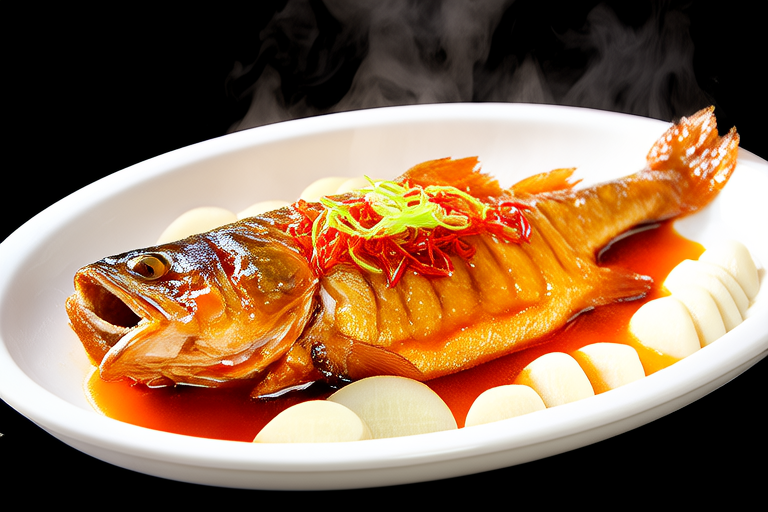Fresh Flavors: Steamed Mandarin Fish in Zhejiang Style
Introduction
Welcome to the world of culinary delights where we explore the rich flavors and traditions of Chinese cuisine. Today, we delve into the heart of Zhejiang Province, known for its delicate and sophisticated dishes. The Steamed Mandarin Fish in Zhejiang Style is a classic dish that exemplifies the province’s emphasis on freshness, simplicity, and balance. This recipe not only highlights the natural sweetness of the fish but also incorporates a harmonious blend of flavors that will tantalize your taste buds.
The Significance of Mandarin Fish
Mandarin fish, scientifically known as Siniperca chuatsi, is a freshwater species native to East Asia. It is prized for its tender flesh and mild flavor, making it an ideal candidate for steaming. In Zhejiang cuisine, this fish is often prepared in its simplest form to let its inherent qualities shine through. The fish is typically sourced from pristine rivers and lakes, ensuring its freshness and quality.
Ingredients
- Fresh Mandarin Fish: Choose a fish weighing around 1-1.5 kilograms for optimal results. Ensure the fish is fresh, with clear eyes and firm skin.
- Garlic: Minced garlic adds a pungent aroma and enhances the overall flavor profile.
- Ginger: Thinly sliced ginger provides a subtle warmth and complements the fish’s mildness.
- Scallions: Finely chopped scallions add a fresh, crisp texture and a touch of green to the dish.
- Shaoxing Rice Wine: A staple in Zhejiang cooking, this rice wine imparts a fragrant and slightly sweet flavor.
- Soy Sauce: Light soy sauce is used for seasoning without overpowering the fish’s natural taste.
- Vinegar: A small amount of vinegar adds a tangy note and helps to cut through any richness.
- Sugar: Just a pinch of sugar enhances the natural sweetness of the fish.
- Olive Oil: Drizzled lightly over the fish after steaming to增添风味。
Preparation
Before beginning, ensure all ingredients are at room temperature and prepare your steamer. Cleaning the fish is crucial; start by scaling and gutting the fish. Rinse it thoroughly under cold water and pat dry with paper towels. To enhance the flavor, make several diagonal cuts along the sides of the fish. These cuts not only help the fish cook more evenly but also allow the marinade to penetrate deeper.
In a bowl, mix together minced garlic, thinly sliced ginger, Shaoxing rice wine, light soy sauce, vinegar, and sugar. Pour this mixture over the fish, ensuring it is well-coated. Allow the fish to marinate for about 30 minutes to an hour, depending on your preference for intensity of flavor.
Meanwhile, prepare the steamer. Place a heatproof plate inside the steamer basket and set it over boiling water. Arrange the marinated fish on the plate, ensuring it is positioned upright for even cooking. Cover the steamer and steam the fish for approximately 8-10 minutes per 500 grams of fish. Use a fork to gently check if the flesh flakes easily; this indicates the fish is perfectly cooked.
Once the fish is done, remove it from the steamer and transfer it to a serving platter. Sprinkle finely chopped scallions and additional slices of ginger over the fish. Drizzle a small amount of olive oil over the top for added richness and finish with a light sprinkle of sesame seeds for a crunchy texture.
Serving Suggestions
The Steamed Mandarin Fish in Zhejiang Style is best enjoyed as part of a larger meal, complemented by steamed vegetables such as bok choy or spinach, and perhaps a side of jasmine rice. The fish’s delicate flavor pairs wonderfully with the freshness of the vegetables and the subtle sweetness of the rice. For those who enjoy a bit more spice, a side of chili oil can be drizzled over the vegetables to add a fiery kick.
Cultural Insights
Zhejiang cuisine, with its emphasis on seafood and freshwater fish, reflects the region’s geographical diversity. The province’s coastal areas provide an abundance of seafood, while its numerous rivers and lakes offer a variety of freshwater fish. The use of light sauces and minimal seasoning in dishes like this one allows the natural flavors of the ingredients to take center stage. This approach to cooking is deeply rooted in the cultural belief that food should be enjoyed for its inherent goodness, rather than being masked by heavy spices or sauces.
Nutritional Benefits
Mandarin fish is a nutritional powerhouse, rich in high-quality protein, omega-3 fatty acids, and essential vitamins and minerals. Omega-3s are particularly beneficial for heart health, while the protein content supports muscle repair and growth. Additionally, the fish’s low calorie and fat content make it an excellent choice for those looking to maintain a healthy diet.
Conclusion
The Steamed Mandarin Fish in Zhejiang Style is more than just a dish; it is a celebration of simplicity and freshness. By allowing the natural flavors of the fish to come through, this recipe showcases the elegance and sophistication of Zhejiang cuisine. Whether you’re a seasoned chef or a novice in the kitchen, this dish is sure to impress and delight your guests. Enjoy the process of preparing and savoring this timeless classic.


